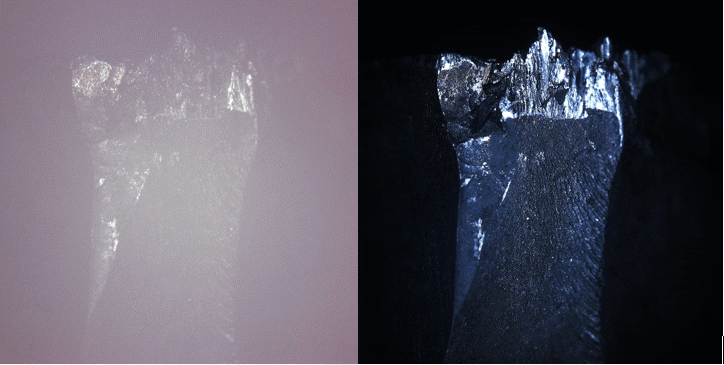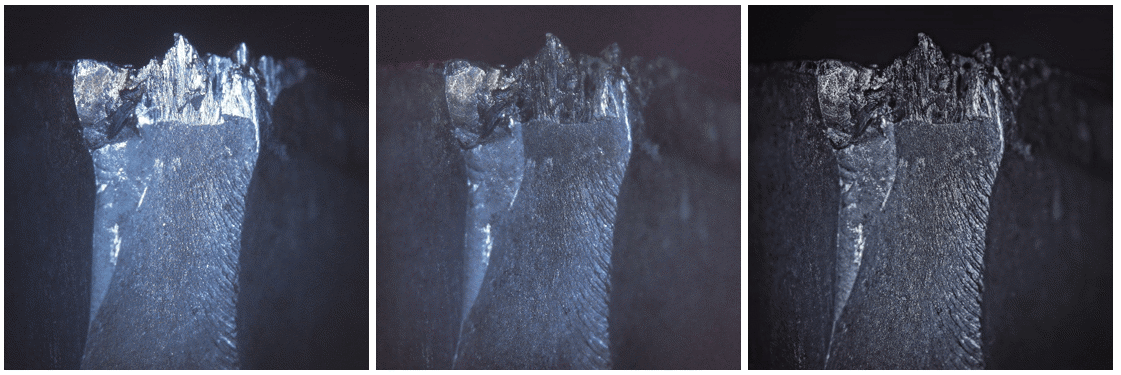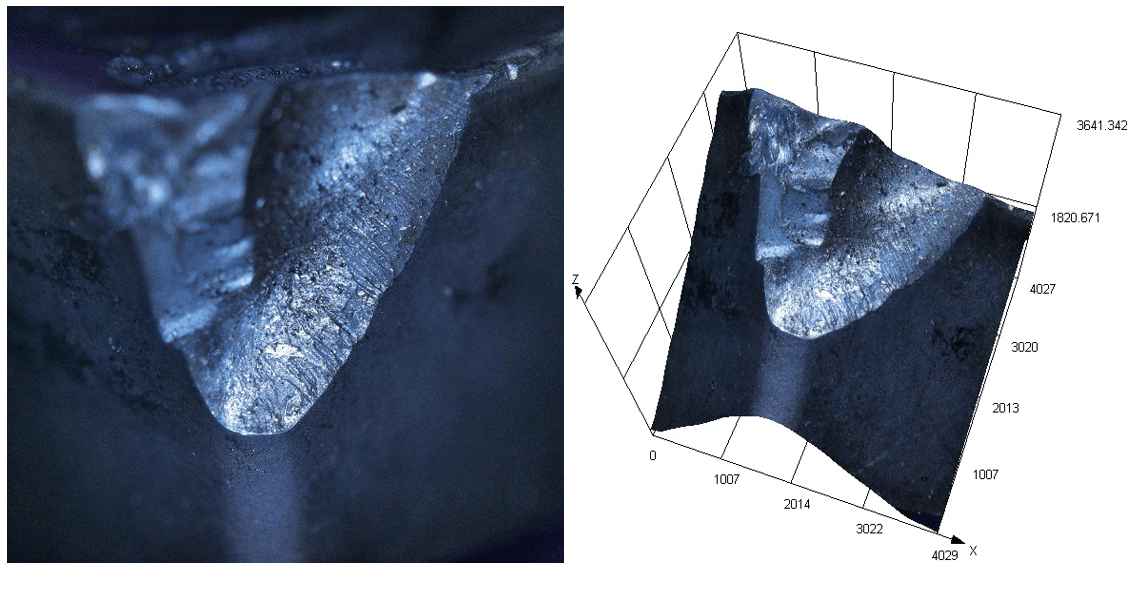In this interview, Marcel Lucas describes the importance of assessing tool wear use and how Olympus provide the ideal digital microscopy solution to quantify tool wear detection, conducted at MRS 2018 by Alina Shrourou, BSc.
Please define the term “tool wear detection”.
Here we are focusing on three general kinds of cutting tools: drill bits used for drilling holes; end mills, which are cutting tools used to prepare very large flat surfaces; and indexable inserts, which are removable cutting tips you can insert on a lathe to cut a cylindrical sample.
When you cut a sample with one of these cutting tools, there is considerable friction between the tool and the sample. Over time, this friction causes some of the material from the tool to be lost. Eventually, the tool wears out and is too blunt to cut the sample. The tool must then be replaced.
Digital microscopy can be used to detect wear and quantify it as a function of time so that you can predict the expected life of a cutting tool and determine when to replace it.
Why is it important to regularly assess tool wear? What does it protect?
Regular tool wear assessment helps protect product quality, performance, and the bottom line. When you cut a sample with a worn tool, the dimensions of the machined part may not match the dimensions specified by the customer. The machined part is often slightly larger than what it should be. When this happens, you end up with parts that don’t fit together because they were not machined with the right dimensions. So dimensional accuracy is a big quality problem.
Another quality issue is higher surface roughness when you use a worn tool to cut a sample. In addition, a worn tool can also introduce residual stresses into the sample. Surface roughness and residual stresses can lead to a shorter service life and poorer mechanical performance of the machined parts.
These quality issues result in a lot of scrapped parts and increased costs, as replacement parts must be machined again.
What is the typical method currently used to quantitatively assess tool wear?
There are two main techniques used to detect tool wear. One is scanning electron microscopy (SEM), and the other is conventional optical microscopy. However, each technique has its own issues.
On the one hand, SEM is a great tool for examining samples, but not well suited for accurate 3D measurements because of its large depth of field. And you need 3D images of your tools to assess the changes in tool geometry because of tool wear.
On the other hand, a conventional optical microscope cannot image a tall object, like a cutting tool, and keep the entire image in focus. This is because of the limited depth of field of the objective lenses.
Describe the benefits of digital microscopy compared to conventional optical microscopy for the detection and quantitation of tool wear.
In conventional optical microscopy, the sample is typically illuminated from above through an objective lens, and the same objective lens collects the light reflected off the sample. This is what we call brightfield illumination. Brightfield illumination causes excessive glare from reflective samples such as cutting tools, which significantly reduces image contrast (Fig. 1a).
The great thing with a digital microscope is that, with a click of a button, you can switch from brightfield illumination to darkfield illumination to reduce glare (Fig. 1b). With darkfield illumination, you are illuminating the sample from the side at an angle instead of illuminating the sample from above. Most of the glare is eliminated, and you are able to see the cutting tool more clearly because the objective is not collecting the reflection of the incident light.
In addition to the different illumination modes, you can also process the image within a digital microscope to enhance the dynamic range of your image, meaning that you can image a wider range of light intensities. By increasing the dynamic range, you can image bright and dark areas at the same time without losing any of the details, while further reducing glare.

Fig. 1. Build up edge on indexable milling insert with (a) bright-field, (b) dark-field).
Can brightfield and darkfield illumination be combined to enhance the accuracy of tool wear analysis?
The combination of brightfield and darkfield illumination in Olympus digital microscopes is a proprietary technology that we call MIX illumination. Using MIX illumination, you can simultaneously image both the bright reflective areas and the darker areas of a sample, without saturating the bright areas or without areas that are so dark that you cannot resolve the details. MIX illumination enhances contrast (Fig. 2a). Since height measurement calculations are based on contrast, MIX illumination improves height measurement accuracy.
What digital microscopy solutions can Olympus provide to support tool wear detection and quantitation?
MIX illumination (Fig. 2a) and digital processes such as WiDER (another proprietary technology from Olympus) (Fig. 2b) and HDR (Fig. 2c) are very effective at reducing glare from reflective surfaces on tool cutting edges.

Fig. 2. Build up edge on indexable milling insert. (a) Original image with MIX illumination, (b) image with WiDER, (c) image with HDR.
Using the Olympus DSX510 upright digital microscope or the DSX510i inverted digital microscope, you can acquire 3D images of your cutting tool. 3D images are important because they reveal significantly more information about the tool geometry to help you answer questions such as: How much of the tool material is lost? Is there one side of the cutting edge that is wearing out faster than the other? These are questions you cannot answer with a 2D image (Fig. 3a). Only a 3D image can provide answers (Fig. 3b), and 3D imaging is possible with a digital microscope.

Fig. 3. Image of fractured indexable milling insert; (a) 2D (b) 3D.
What kinds of industries can benefit from tool wear detection?
Cutting tools are used in large sectors of the economy - construction, automotive, aerospace, defense, and oil & gas industries. They are used to manufacture medical devices, engines, pumps, and fasteners such as screws, nuts, and bolts.
How do the DSX510 and DSX510i offer guaranteed measurement accuracy?
When it comes to hardware, both microscopes are built around very sturdy frames to reduce vibrations. The imaging software also has a feature to stabilize the image in the presence of vibrations.
We also have dedicated telecentric objectives for the DSX510 and the DSX510i digital microscopes. What's great about these objectives is that the dimensions of an object remain the same when the object moves closer to, or further away from the objective. So the measurement does not depend on how you focus the sample. And that reduces subjectivity and improves accuracy.
Finally, the microscopes’ software enables you to automatically calibrate the microscope using a calibration standard, ensuring that measurements are reproducible and accurate.
About Marcel Lucas

Marcel graduated from the University of Manchester, England with a Ph.D. in Material Science. Following this, Marcel completed a series of postdoctoral positions in the United States. First, at Georgia Tech, Marcel continued his work on nanomaterials using Raman spectroscopy and atomic force microscopy. Marcel then went to Los Alamos National Laboratory where he used fluorescence and Raman microscopy to investigate the effects of different pre-treatments on wood and how to pre-treat them so they can be converted into biofuels.
Marcel later worked at Washington State University where he studied the phase transformation of graphite to diamond under shock compression. Marcel then relocated to Houston, Texas and worked in the private sector; first, as a project engineer in a materials testing lab, and then as a technical and sales support specialist at Olympus.

This information has been sourced, reviewed and adapted from materials provided by Evident Corporation.
For more information on this source, please visit Evident Corporation.
Disclaimer: The views expressed here are those of the interviewee and do not necessarily represent the views of AZoM.com Limited (T/A) AZoNetwork, the owner and operator of this website. This disclaimer forms part of the Terms and Conditions of use of this website.